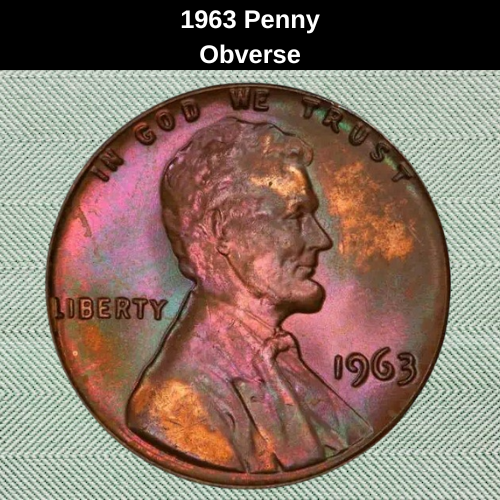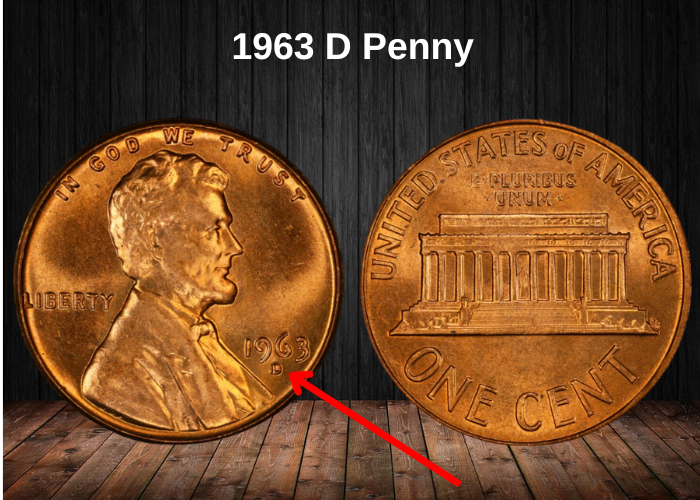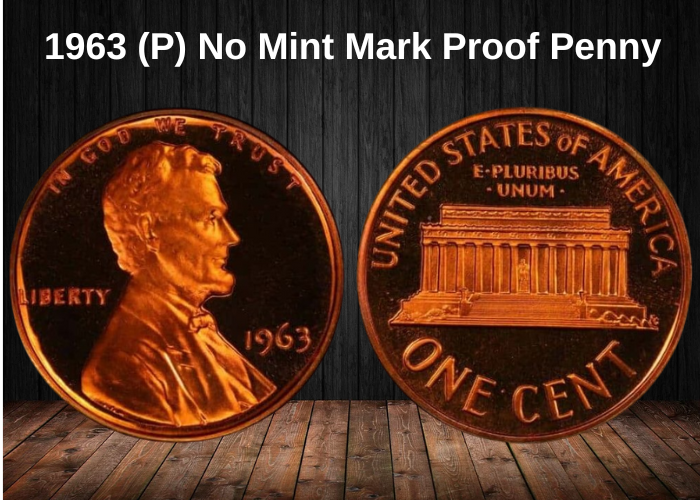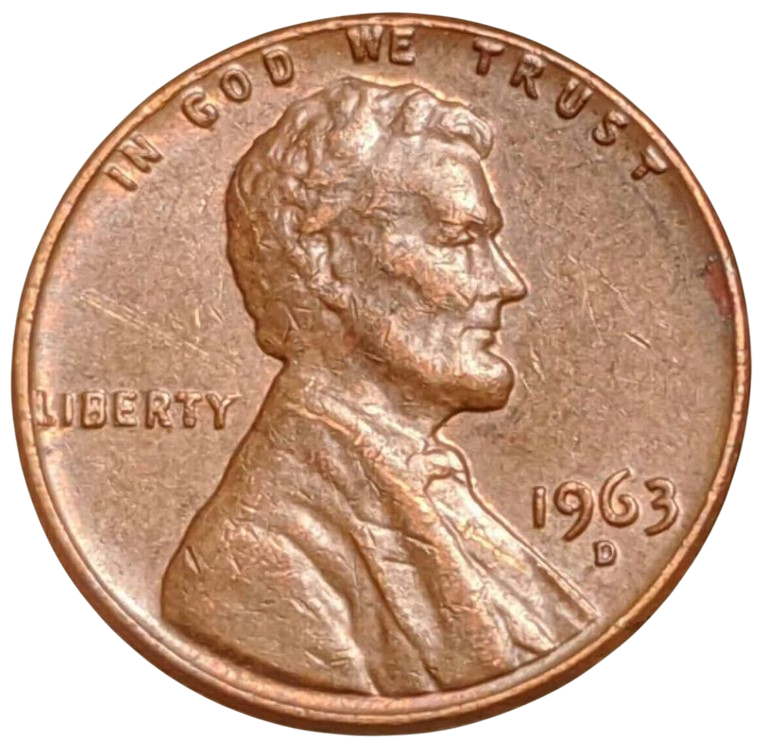Have you come across a 1963 penny and wondered if it might be worth more than just one cent? Whether you’ve found it in pocket change or you’re a dedicated collector, this guide will help you explore its potential value.
Let’s break down the 1963 penny value by condition, mint mark, and proof status:
1963 Penny Value Chart (for red-graded coins – RD)
| Mint Mark | MS63 | MS65 | MS67 |
|---|---|---|---|
| 1963 (P) No Mint Mark | $6 | $18 | $850 |
| 1963 D (Denver Mint) | $3 | $20 | $14,500 |
| Proof Grade | PR63 | PR65 | PR67 |
|---|---|---|---|
| 1963 No Mint Mark Proof | $10 | $14 | $20 |
| Cameo Proof | $11 | $16 | $26 |
History of the 1963 Penny

The 1963 Lincoln penny continued a long-standing tradition that began in 1909, marking 100 years since the birth of President Abraham Lincoln. That year, the U.S. Mint introduced the first cent to feature a real historical figure—Lincoln himself.
The obverse (front) of the 1963 penny still carries the original Victor D. Brenner portrait of Lincoln, unchanged since 1909. However, the reverse (back) design had evolved. Early Lincoln cents featured two ears of wheat, known as “Wheat Pennies.” But in 1959, to celebrate Lincoln’s 150th birthday, the reverse was updated to show the Lincoln Memorial in Washington, D.C.
This makes the Lincoln Memorial penny one of the few U.S. coins to depict the same person on both sides—Lincoln’s profile on the front and his seated statue in the memorial on the back.
Composition and Specifications
Though it weighed the same as earlier pennies (3.11 grams), the composition of the 1963 penny was different. While pre-1962 cents were made of 95% copper, 5% tin and zinc (bronze), Congress authorized the removal of tin in September 1962, shifting the composition to 95% copper and 5% zinc—technically making the coin brass, not bronze.
This adjustment was made to simplify production without compromising durability. The Lincoln Memorial design continued until 2008, after which it was replaced with the Union Shield design in 2010.
Features of the 1963 Penny
The Obverse of the 1963 Penny

The obverse, or “heads” side, of the 1963 Lincoln penny features a portrait that has become iconic to Americans: President Abraham Lincoln. This design, still used on pennies today, was first introduced in 1909 and was created by sculptor Victor David Brenner.
Brenner aimed to depict Lincoln with a lively and thoughtful expression, inspired by a photograph believed to have been taken at the studio of famed Civil War-era photographer Matthew Brady. Though it’s unclear whether Brady himself or an assistant took the photo, it served as the key reference for the coin’s design.
Initially, Brenner included his full signature on the coin, but the U.S. Mint objected, citing concerns over self-promotion. As a compromise, his initials “VDB” were placed on the reverse. However, public backlash—claiming the initials were too conspicuous—led to their removal later in 1909. They were discreetly reinstated on the cut-off of Lincoln’s bust in 1918, where they can still be seen on the 1963 penny if you look closely.
Along with Lincoln’s profile, the obverse features:
- The national motto “In God We Trust” inscribed above his head
- The word “Liberty” to the left
- The date “1963” to the right
- A small “D” mint mark just below the date if the coin was struck in Denver (no mark indicates Philadelphia)
The Reverse of the 1963 Penny

The reverse side of the 1963 Lincoln penny features the Lincoln Memorial, a structure located in Washington, D.C., honoring the 16th U.S. president. This design was first introduced in 1959 to commemorate the 150th anniversary of Abraham Lincoln’s birth, replacing the earlier wheat ears reverse used from 1909 to 1958.
At the bottom of the coin, following its curvature, appears the denomination “ONE CENT” in bold letters. The top edge bears the inscription “UNITED STATES OF AMERICA”, in smaller capital letters that also follow the contour of the coin.
Just beneath the country name is the Latin motto “E PLURIBUS UNUM”, which translates to “Out of many, one.” This phrase refers to the unification of the original thirteen colonies into a single nation.
One unique detail of this reverse design is that Lincoln’s statue is faintly visible within the central portico of the Memorial. That makes this one of the very few U.S. coins to depict the same person on both sides.
Other Features of the 1963 Penny
While the 1963 Lincoln penny retained the traditional 95% copper composition of earlier issues, an important change was introduced the previous year. In 1962, the tin was removed from the alloy, leaving the remaining 5% composed entirely of zinc. This shift from bronze to brass aimed to simplify manufacturing without altering the coin’s durability or appearance.
Despite the change in alloy, the weight and dimensions of the penny remained unchanged:
- Weight: 3.11 grams
- Diameter: 19 millimeters
Color and Surface Grading
Because of the high copper content, the surface color of 1963 pennies can vary significantly depending on their condition and exposure to air.
- Uncirculated coins tend to retain their original bright red luster.
- Circulated examples typically darken to brown or red-brown over time.
Color is a critical factor in value assessment, especially for collectors. Grading is typically divided into three categories:
- Red (RD): 95% or more of the surface retains the original coppery red tone.
- Red-Brown (RB): Between 5% and 95% of the red color remains.
- Brown (BN): Less than 5% of the red luster is present, with the coin appearing mostly brown.
Coins with full red coloration generally command higher prices than their red-brown or brown counterparts.
Want to understand more about color grading Lincoln pennies? Check out this CoinOpp video on YouTube for a helpful visual guide.
1963 Penny Grading Guide
Understanding your coin’s grade is essential for determining its value. Coin grading assesses a penny’s condition, from heavy wear to flawless mint state. Here’s a quick look at the common grading scale used by collectors and professional grading services:
| Grade Number | Grade Description |
|---|---|
| 1 | Basal State-1 |
| 2 | Fair |
| 3 | Very Fair |
| 4, 5, 6 | Good |
| 7, 8, 10 | Very Good |
| 12, 15 | Fine |
| 20, 30 | Very Fine |
| 40 | Extremely Fine |
| 50 | About Uncirculated |
| 60 | Mint State (MS60) |
| 65 | Mint State (MS65 – Gem) |
| 70 | Mint State (MS70 – Perfect) |
As a general rule:
- Lower grades (1–10) show heavy wear and may lack details.
- Mid-range grades (12–40) retain some design elements but show signs of circulation.
- Higher grades (50–70) are usually uncirculated, with MS70 being flawless under magnification.
🔍 Tip: Always consult a reputable coin grading guide or submit your coin to a professional grading service like PCGS or NGC to get an accurate assessment.
1963 Penny Value Guides
1963 (P) No Mint Mark Penny Value

To determine if your 1963 penny was minted in Philadelphia, check the front (obverse) of the coin. If there’s no mint mark beneath the date, that means it came from the Philadelphia Mint. As the first U.S. Mint facility, Philadelphia didn’t initially use a mint mark.
In 1963 alone, Philadelphia produced over 750 million Lincoln pennies. So it’s no surprise that these coins are still fairly common today. You can even come across uncirculated examples in everyday pocket change.
Value Based on Condition and Color
The coin’s value depends heavily on both its grade and color. Coins are graded on a 1 to 70 scale, with 70 representing a perfect, mint state. Any penny graded 60 or higher is considered “mint state.” For 1963 Philadelphia pennies, most circulated examples—especially brown or red-brown ones—are usually worth just face value, unless they have a notable error.
However, red coins in high grades are a different story. A red 1963 Philadelphia penny graded MS63 is valued at around $6, according to PCGS. That’s a solid return for a coin you might still find in circulation.
At MS65, its value increases to about $18. And at the rare MS67 grade, only 21 coins have been certified, with each worth approximately $850.
The rarest known examples are graded MS67+, with only two known to exist. These exceptional coins are each estimated to be worth around $9,000.
1963 D Penny Value

The Denver Mint was extremely productive in 1963, minting over 1.77 billion Lincoln cents—more than double the number produced in Philadelphia. If your coin has a small “D” beneath the date on the front (obverse), it was struck in Denver.
Just like the Philadelphia versions, most Denver-minted pennies in brown or red-brown condition are worth no more than one cent. However, it’s much harder to come across red Denver cents in the higher grades.
A red 1963-D penny graded MS63 is worth around $3, about the same as its Philadelphia counterpart. But once you reach grades above MS65, the value increases significantly.
An MS66 red example can be valued at about $80—almost three times more than a similar Philadelphia coin. If the coin is graded MS66+, its value can rise to $450. And at MS67, these coins become extremely rare. The PCGS has certified only nine in this grade, each valued at an impressive $14,500.
1963 (P) No Mint Mark Proof Penny Value

In addition to the standard “business strike” coins, the Philadelphia Mint also produced proof pennies in 1963. These coins were created specifically for collectors, using highly polished blanks (planchets) and carefully prepared dies to produce sharp, detailed finishes.
More than 3 million proof coins were minted that year. Because they were intended as collector’s items from the beginning, most have been well preserved. This widespread availability helps keep their market value relatively low.
Proof pennies from 1963 are typically classified into three finish types: Red, Cameo, and Deep Cameo.
- Red is the most basic level.
- Cameo coins display a beautiful contrast between their mirror-like backgrounds and frosted raised details.
- Deep Cameos show the strongest contrast, making them the most sought after.
A 1963 red proof penny can range in value from $6 at PR60 (Proof 60) up to around $100 at PR69.
Deep cameo examples, on the other hand, command higher prices. Values begin at about $8 for PR60 and can reach $300 for PR69.
There’s even one known deep cameo that achieved a perfect PR70 grade. That coin sold for an astounding $40,250 at auction back in 2004—a record-setting price for this type.
Rare 1963 Penny Error List
1963 D Penny, Double Die Obverse

A double die error occurs when a die used to strike coins becomes misaligned during its manufacturing process. The die is struck by a hub multiple times to ensure that the design transfers clearly, but if the die or hub is misaligned between strikes, it can create a double image. This error then appears on the coins struck by the misaligned die.
- If the misalignment happens on the obverse (front) die, it’s called a double die obverse (DDO).
- If it happens on the reverse (back) die, it’s referred to as a double die reverse (DDR).
For the 1963 penny, some of the coins minted at the Denver Mint exhibit double die obverse errors. The most noticeable doubling is found on the number 3 in the date.
The value of these coins depends on their color and condition, just like any other penny, but the error adds an extra layer of collectibility. Records of sales for these double die errors are somewhat dated, mostly from between 2012 and 2014. Back then, a MS62 grade example could sell for $25 to $30.
The highest known grade for these coins is MS65, and the last known sale of an MS65 grade 1963 double die obverse penny was in 2014, with the coin fetching $209.
1963 D Penny with Re-punched Mint Mark (RPM)
One interesting error found in some 1963 Denver pennies is the re-punched mint mark (RPM). This occurs when the mint mark is struck more than once, resulting in a shadow or ghost of the original mint mark appearing behind the second strike. These varieties are highly collectible due to their unique nature, but spotting them requires careful inspection. You’ll likely need a microscope or a loupe to see the re-punched mint mark clearly.
The varieties are identified by a specific code based on the position of the mint marks. For example:
- RPM-001: The first mint mark is located to the west (left) of the second.
- RPM-017: The second mint mark is located south (below) the first.
As of recent sales, uncertified 1963 D pennies with re-punched mint marks were listed with prices ranging from $3.75 to $75 depending on the condition and rarity of the specific RPM variety.
Where to sell your penny?
Now that you know the value of your penny, you might be wondering where to sell it. Don’t worry: here’s a guide to some of the best online platforms where you can easily sell your coins, along with their advantages and disadvantages.
Discover the best platforms for selling coins online (pros and cons).
FAQ About the 1963 Lincoln Penny
1. What is the significance of the 1963 Lincoln Penny?
The 1963 Lincoln Penny is part of the Lincoln Memorial series (1959–2008) and holds historical significance as part of the large-scale coin production in the 1960s. It was struck in the years following the introduction of the Lincoln Memorial reverse, which replaced the Wheat reverse. The 1963 penny is mostly common, but certain high-grade examples and error varieties can be valuable to collectors.
2. What is the composition of the 1963 Lincoln Penny?
The 1963 Lincoln Penny is made of:
- 95% copper
- 5% tin and zinc
It weighs 3.11 grams, which is consistent with the standard weight of pennies produced between 1909 and 1982. This composition remained unchanged until the U.S. Mint transitioned to the copper-plated zinc penny in 1982.
3. How many 1963 Lincoln Pennies were minted?
In 1963, the total mintage of the Lincoln Penny was as follows:
- Philadelphia Mint (no mintmark): 1,328,120,000
- Denver Mint (D): 1,736,460,000
A total of 3.06 billion 1963 pennies were produced, making them extremely common in circulation, especially in lower grades.
4. Are there any rare varieties or errors in the 1963 Lincoln Penny?
While the 1963 Lincoln Penny does not have major varieties like some earlier years, mint errors do exist and are of interest to collectors. These errors include:
- Die cracks: Raised lines or breaks caused by cracks in the die.
- Off-center strikes: Misaligned strikes that result in an off-center design.
- Clipped planchets: Partial coins due to errors during the blanking process.
- BIE error: A die break between the “B” and “E” of “LIBERTY,” causing it to look like an “I.”
Coins with these errors, particularly in uncirculated or high-grade condition, can fetch a premium.
5. What is the value of a 1963 Lincoln Penny today?
The value of a 1963 Lincoln Penny varies based on its condition:
| Condition | 1963 (No Mintmark) | 1963-D |
|---|---|---|
| Circulated | $0.01–$0.05 | $0.01–$0.05 |
| Uncirculated (MS60) | ~$0.10–$0.25 | ~$0.10–$0.25 |
| MS63 Red | ~$1–$2 | ~$1–$2 |
| MS65 Red | $5–$10 | $5–$10 |
| With major errors | Varies ($10–$100+) | Varies ($10–$100+) |
Coins in high-grade uncirculated condition (MS-65 and above) can bring in $5–$10 depending on their quality. Proof versions were not issued for business strikes in 1963, as only proof sets were made by the Philadelphia Mint that year.
6. How do I identify a high-grade 1963 Lincoln Penny?
A high-grade 1963 penny should have:
- Sharp, crisp details: The Lincoln portrait and wheat stalks should be well-defined, with no visible wear or fading.
- Smooth, clean surfaces: Minimal to no contact marks, scratches, or abrasions.
- Strong luster: The coin should have a reflective shine, especially in areas where the original luster has been preserved.
- Well-defined rims: The rims around the coin should be intact, with no wear or damage.
If the penny is in MS-65 or higher condition, it should have a flawless appearance with no signs of circulation.
7. Is the 1963 Lincoln Penny worth collecting?
Yes, while the 1963 Lincoln Penny is common and not as valuable in lower grades, it can still be worth collecting if:
- You are building a complete Lincoln Memorial series.
- You find high-grade examples, especially in MS-65 or above.
- You come across rare error varieties such as off-center strikes or die cracks.
Although not known for significant errors or low mintage, the 1963 penny offers a solid foundation for those starting to collect U.S. coins.


















































